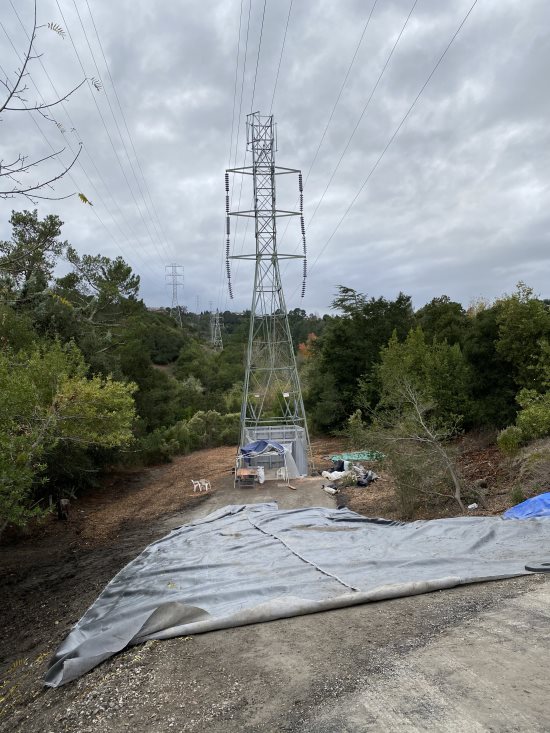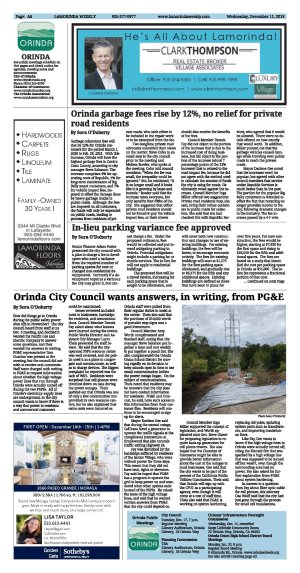| | Published December 11th, 2019
| Orinda City Council wants answers, in writing, from PG&E
| | | By Sora O'Doherty |  | | Photo Sora O'Doherty |
How did things go in Orinda during the public safety power shut offs in November? The city council heard from staff at its Dec. 3 meeting, and decided it wanted the Pacific Gas and Electric Company to answer some questions, and they wanted the answers in writing. PG&E representative Tom Guarino was present at the meeting, but the council did not wish to receive oral comments. Staff were charged with writing to PG&E to request information about whether the high voltage power lines that run through Orinda were actually turned off during the two PSPSs. All of Orinda's electricity supply lines are underground, so the city council wants to know if there is a way that power to residents and commercial customers could be maintained.
 Issues reviewed included costs to businesses, hardships for residents, and communications. Council Member Dennis Fay asked about what lessons were learned during the events. Public Works Director and Assistant City Manager Larry Theis presented the staff review. He said that the city-operated PSPS resource center was well received, and the public used it as a place to congregate and communicate, as well as to charge devices. The biggest complaint he reported was the lack of WiFi. Residents were surprised that cell phones were throttled down on data during the power outages. Theis pointed out that Orinda was one of only a few communities that provided its own resource centers, but he also explained that extra costs were incurred as Orinda staff were pulled from their regular duties to assist at the center. Theis also said that the purchase of $10,000 worth of portable stop signs was a good investment.
Issues reviewed included costs to businesses, hardships for residents, and communications. Council Member Dennis Fay asked about what lessons were learned during the events. Public Works Director and Assistant City Manager Larry Theis presented the staff review. He said that the city-operated PSPS resource center was well received, and the public used it as a place to congregate and communicate, as well as to charge devices. The biggest complaint he reported was the lack of WiFi. Residents were surprised that cell phones were throttled down on data during the power outages. Theis pointed out that Orinda was one of only a few communities that provided its own resource centers, but he also explained that extra costs were incurred as Orinda staff were pulled from their regular duties to assist at the center. Theis also said that the purchase of $10,000 worth of portable stop signs was a good investment.
 Council Member Amy Worth complimented and thanked staff, noting that city manager Steve Salomon put together a team and met weekly to put together a punch list. She also complimented the Orinda Union School District for moving rapidly on its decision to keep schools open in time to use email communication before the power outage began. On the subject of communications, Theis noted that residents may be unaware that the city does not have contact information for residents. PG&E and Comcast, he said, have such access to this information from their customer files. Residents will continue to be encouraged to sign up for alerts.
Council Member Amy Worth complimented and thanked staff, noting that city manager Steve Salomon put together a team and met weekly to put together a punch list. She also complimented the Orinda Union School District for moving rapidly on its decision to keep schools open in time to use email communication before the power outage began. On the subject of communications, Theis noted that residents may be unaware that the city does not have contact information for residents. PG&E and Comcast, he said, have such access to this information from their customer files. Residents will continue to be encouraged to sign up for alerts.
 Mayor Darlene Gee said that during the second outage, CalTrans hired a generator to operate the traffic signals at the complicated intersection at Brookwood that also controls traffic exiting Highway 24.
Mayor Darlene Gee said that during the second outage, CalTrans hired a generator to operate the traffic signals at the complicated intersection at Brookwood that also controls traffic exiting Highway 24.
 Fay was disturbed by the hardships suffered by residents of the Senior Village, who were without power for three days. This meant that they did not have heat, lights or elevators. Fay said he hoped that PG&E has a program to operate the grid to keep power on and wondered what other options exist instead of the PSPSs. He raised the issue of the high voltage lines, and said that he wanted written answers from PG&E that the city could depend on.
Fay was disturbed by the hardships suffered by residents of the Senior Village, who were without power for three days. This meant that they did not have heat, lights or elevators. Fay said he hoped that PG&E has a program to operate the grid to keep power on and wondered what other options exist instead of the PSPSs. He raised the issue of the high voltage lines, and said that he wanted written answers from PG&E that the city could depend on.
 Council Member Inga Miller supported the concept of legislation, and Worth applauded state Sen. Steve Glazer for proposing legislation to require back-up generators for cell phone towers. She also hoped that the Chamber of Commerce might be able to provide better information about the cost of the outages to local businesses. Gee said that the city wants to be part of the process of the California Public Utilities Commission. Theis said that Orinda will sign up with the CPUC as a participating agency, even though it will come at a cost of staff time. Theis also said that PG&E is working on system hardening, replacing old poles, updating system parts such as transformers, and improving insulation on lines.
Council Member Inga Miller supported the concept of legislation, and Worth applauded state Sen. Steve Glazer for proposing legislation to require back-up generators for cell phone towers. She also hoped that the Chamber of Commerce might be able to provide better information about the cost of the outages to local businesses. Gee said that the city wants to be part of the process of the California Public Utilities Commission. Theis said that Orinda will sign up with the CPUC as a participating agency, even though it will come at a cost of staff time. Theis also said that PG&E is working on system hardening, replacing old poles, updating system parts such as transformers, and improving insulation on lines.
 Like Fay, Gee wants to know if the high voltage lines in Orinda were actually turned off, citing the Kincaid fire that was sparked by a high voltage line that was supposed to be turned off but wasn't, even though the surrounding area had no power. Fay also asked for further explanation from PG&E about system hardening.
Like Fay, Gee wants to know if the high voltage lines in Orinda were actually turned off, citing the Kincaid fire that was sparked by a high voltage line that was supposed to be turned off but wasn't, even though the surrounding area had no power. Fay also asked for further explanation from PG&E about system hardening.
 In answer to a question from Fay about fiber optic cable for cell phones, city attorney Osa Wolff said that the city had just gone through the process for small cell installations.
In answer to a question from Fay about fiber optic cable for cell phones, city attorney Osa Wolff said that the city had just gone through the process for small cell installations. |
| | | | | | | | | | | | |




